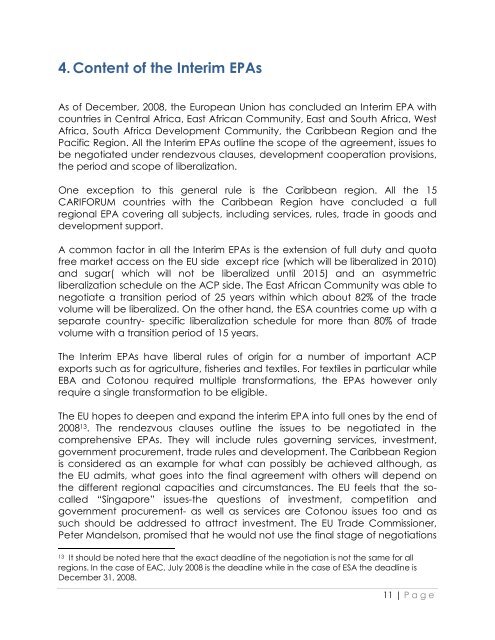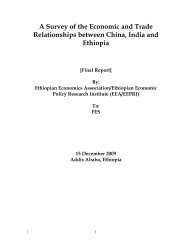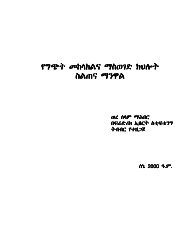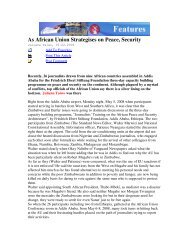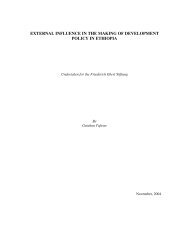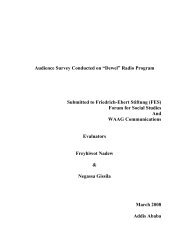Ethiopia and EPA Negotiation 2008 - FES Ethiopia
Ethiopia and EPA Negotiation 2008 - FES Ethiopia
Ethiopia and EPA Negotiation 2008 - FES Ethiopia
You also want an ePaper? Increase the reach of your titles
YUMPU automatically turns print PDFs into web optimized ePapers that Google loves.
4. Content of the Interim <strong>EPA</strong>s<br />
As of December, <strong>2008</strong>, the European Union has concluded an Interim <strong>EPA</strong> with<br />
countries in Central Africa, East African Community, East <strong>and</strong> South Africa, West<br />
Africa, South Africa Development Community, the Caribbean Region <strong>and</strong> the<br />
Pacific Region. All the Interim <strong>EPA</strong>s outline the scope of the agreement, issues to<br />
be negotiated under rendezvous clauses, development cooperation provisions,<br />
the period <strong>and</strong> scope of liberalization.<br />
One exception to this general rule is the Caribbean region. All the 15<br />
CARIFORUM countries with the Caribbean Region have concluded a full<br />
regional <strong>EPA</strong> covering all subjects, including services, rules, trade in goods <strong>and</strong><br />
development support.<br />
A common factor in all the Interim <strong>EPA</strong>s is the extension of full duty <strong>and</strong> quota<br />
free market access on the EU side except rice (which will be liberalized in 2010)<br />
<strong>and</strong> sugar( which will not be liberalized until 2015) <strong>and</strong> an asymmetric<br />
liberalization schedule on the ACP side. The East African Community was able to<br />
negotiate a transition period of 25 years within which about 82% of the trade<br />
volume will be liberalized. On the other h<strong>and</strong>, the ESA countries come up with a<br />
separate country- specific liberalization schedule for more than 80% of trade<br />
volume with a transition period of 15 years.<br />
The Interim <strong>EPA</strong>s have liberal rules of origin for a number of important ACP<br />
exports such as for agriculture, fisheries <strong>and</strong> textiles. For textiles in particular while<br />
EBA <strong>and</strong> Cotonou required multiple transformations, the <strong>EPA</strong>s however only<br />
require a single transformation to be eligible.<br />
The EU hopes to deepen <strong>and</strong> exp<strong>and</strong> the interim <strong>EPA</strong> into full ones by the end of<br />
<strong>2008</strong> 13 . The rendezvous clauses outline the issues to be negotiated in the<br />
comprehensive <strong>EPA</strong>s. They will include rules governing services, investment,<br />
government procurement, trade rules <strong>and</strong> development. The Caribbean Region<br />
is considered as an example for what can possibly be achieved although, as<br />
the EU admits, what goes into the final agreement with others will depend on<br />
the different regional capacities <strong>and</strong> circumstances. The EU feels that the socalled<br />
“Singapore” issues-the questions of investment, competition <strong>and</strong><br />
government procurement- as well as services are Cotonou issues too <strong>and</strong> as<br />
such should be addressed to attract investment. The EU Trade Commissioner,<br />
Peter M<strong>and</strong>elson, promised that he would not use the final stage of negotiations<br />
13 It should be noted here that the exact deadline of the negotiation is not the same for all<br />
regions. In the case of EAC, July <strong>2008</strong> is the deadline while in the case of ESA the deadline is<br />
December 31, <strong>2008</strong>.<br />
11 | P a g e


